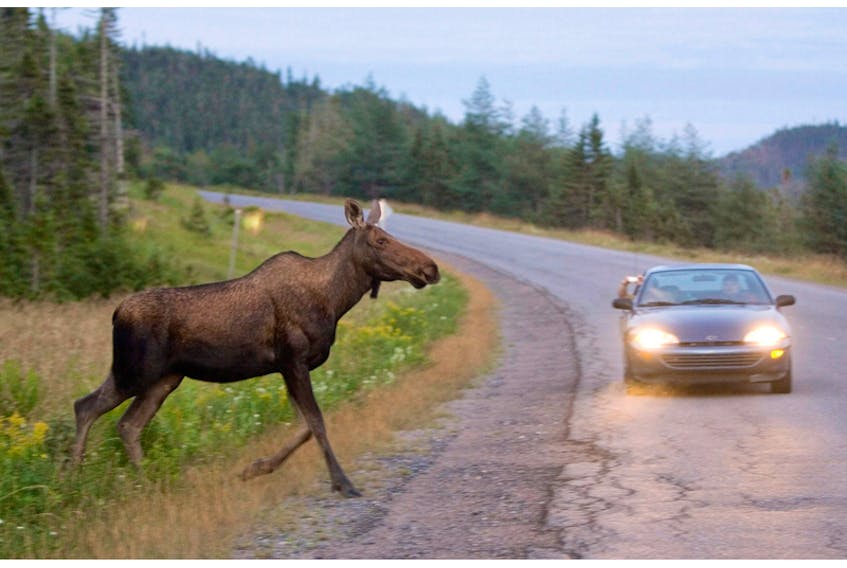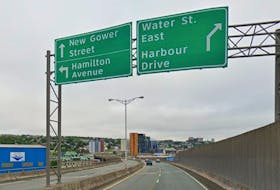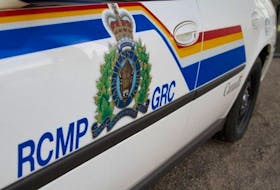On a clear night, an experienced highway driver can detect the reflection of headlights in the eyes of a moose or other animal in time to stop to avoid a collision.
But that is not something most drivers can rely upon. The animals’ eyes can only be detected if the moose is facing or is perpendicular to the oncoming vehicle, and if the weather is clear enough.
Common sense will tell you that reducing speed and keeping a watchful eye scanning both sides of the road is the best way to avoid moose-vehicle collisions.
A newly released national survey from State Farm Canada sheds some light on how Canadians react to wildlife while driving.
What is interesting for this province is that the survey results indicate 20 per cent of Newfoundland drivers do not feel confident that they would know how to avoid a collision with a large animal.
And even with all the awareness campaigns, signage and discussion in Newfoundland and Labrador about moose-vehicle collisions in recent years, 89 per cent of the people surveyed believe better public education about how to react to wildlife on the road is needed to prevent collisions that could lead to injuries and fatalities.
According to State Farm Canada, the survey found about one in three drivers in the country do not feel confident that they would know how to avoid a collision with a large animal, and over 80 per cent believe better public education is needed.
The survey found Canadians are most likely to brake (66 per cent) or take their foot off the gas (55 per cent) when they see an animal on the highway. More than one-third indicated they would honk their horn, and one-quarter said they would swerve.
“The unpredictability of these situations, combined with human impulses to try to preserve the lives of these animals, makes these situations difficult and dangerous,” says John Bordignon of State Farm Canada.
“In fact, according to police and road safety experts, swerving is not the best strategy when approaching wildlife on the road. Instead, they advise drivers to maintain their line, even if it’s toward the animal, and firmly apply the brakes. Swerving could send you into the path of an oncoming vehicle or cause you to lose control of your car.”
The survey also found more than 25 per cent of respondents said they have hit a small animal on the road while driving and more than 25 per cent have either hit or nearly hit a large animal.
Moose-vehicle collisions and ways to prevent them have been a major issue in this province for many years and have led to the formation of organizations such as SOPAC (Save Our People Action Committee).
According to its website, SOPAC was officially formed in 2009 by survivors of moose-vehicle collisions to take on and highlight the problem of moose on the highways in Newfoundland and Labrador.
“It has become evident by the number of moose-vehicle collisions that are reoccurring in many of the same locations and the continued number of moose sightings being recorded in the media and on the various social media channels that there are patterns,” the website states. “Government should recognize them and take action to protect the drivers on our highways.”
As in previous years, this past spring SOPAC partnered with the Government of Newfoundland and Labrador to continue a public education and awareness campaign.
The provincial government stated that in 2016, there were 580 moose-vehicle collisions in Newfoundland and Labrador. While moose-vehicle collisions can happen year-round, most occur between May and October, statistics indicate.
And though moose are more likely to be seen along highways and roadways at dusk and dawn, collisions often take place during other times of the day— especially at night when moose are more difficult to see.
Tips provided by the government and SOPAC on how drivers can avoid collisions include: scan both sides of the highway when you travel; don’t be distracted and pay close attention to highway warning signs; avoid driving at dusk and dawn when moose are more common alongside highways; have passengers also watch for moose; do not drive above posted speed limits; and do not travel at night when moose are more difficult to see.
Windshields and headlights should also be kept clean and drivers should be aware that moose are unpredictable — even if standing calmly on the edge of the road, they could bolt in front of a vehicle at the last moment.









